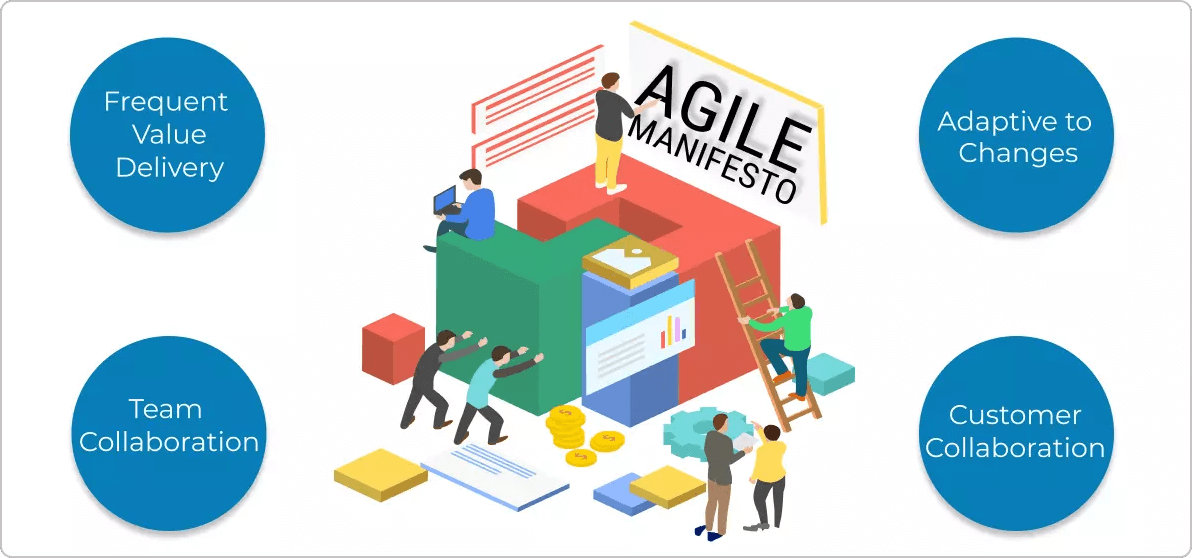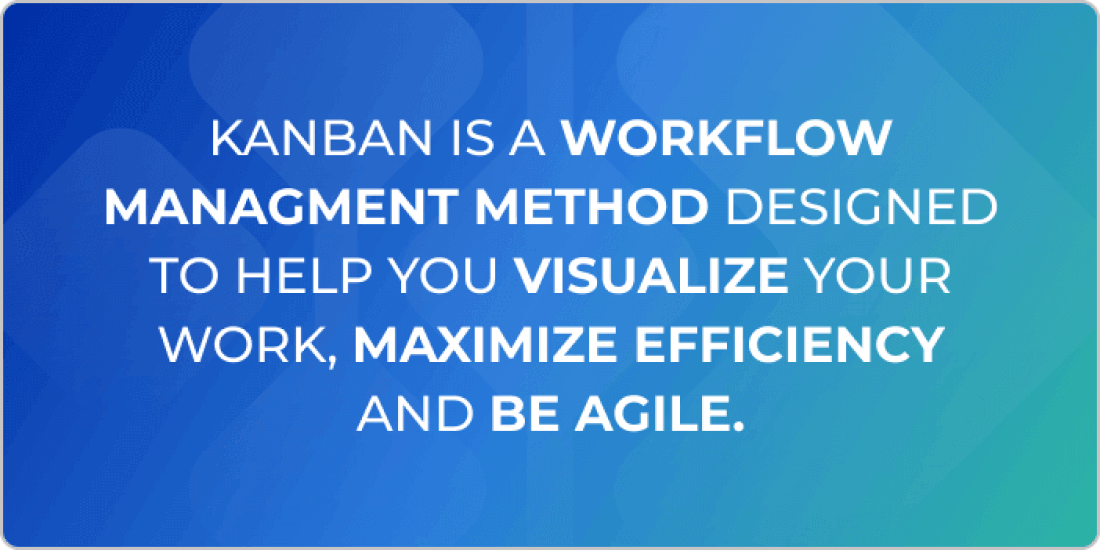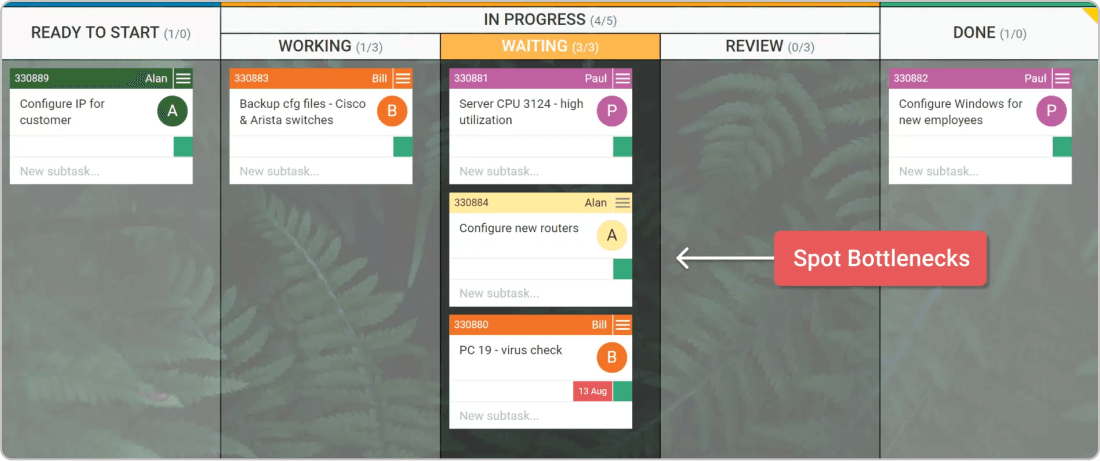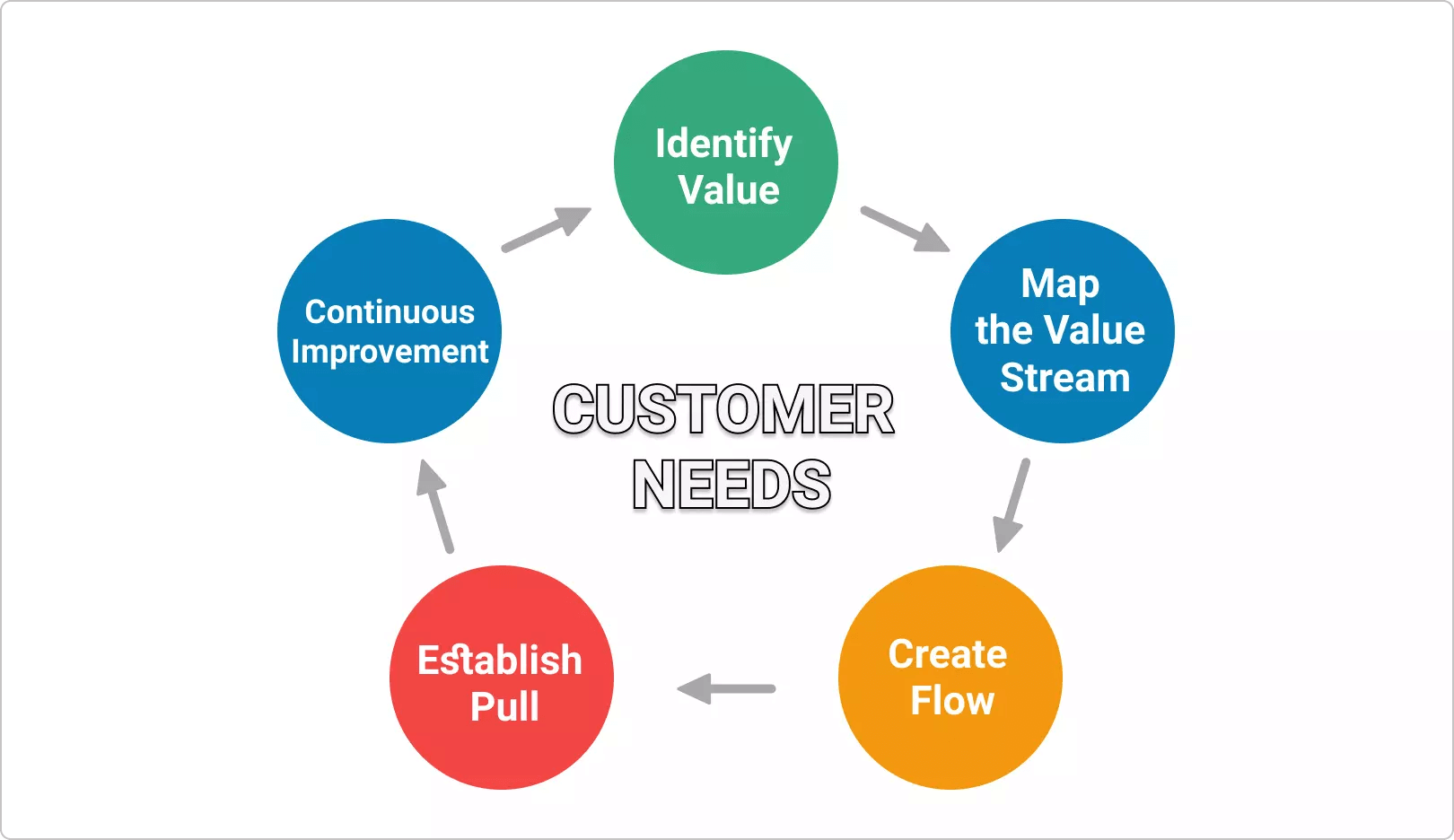As business leaders, we must maximize efficiency, eliminate waste, eliminate roadblocks, and ensure delivery flows smoothly.
To do that and ensure consistency, alignment and business adaptability, the Agile mindset brought different techniques to life. Some of the most commonly used Agile methodologies to shift away from traditional project management include:
-
Kanban
-
Scrum
-
Extreme Programming (XP)
-
Feature-Driven Development
-
Crystal Methodology
-
Lean (Bonus)
Agile Mindset - the Foundation of All Agile Methodologies
Let’s clarify this, Agile is not a methodology. It is a set of values and principles recorded first in the Agile Manifesto. The Manifesto was created as a response to the methods that permeated the software development world despite being notoriously ineffective and counterproductive. Promoting similar values to Lean, Agile methods and techniques mostly focus on the following key principles:
-
Satisfying customers is of foremost importance
-
Develop projects with inspired contributors
-
Interactions are best when done in person
-
Software that works is a measure of progress
-
Reflect and adapt on an ongoing basis
 The 4 Agile Manifesto Core Values
The 4 Agile Manifesto Core Values
So every method, framework, or behavior that follows these values can be named Agile. Regardless of which Agile approach your team adopts - flow-based or iterations-based, the benefits of Agile cannot be fully realized without the commitment of everyone involved. So, here are some examples of the most popular Agile methodologies.
1. Kanban Method (Agile or Lean)
Kanban is a workflow method developed by Toyota engineer Taiichi Ohno for Lean production. Initially designed as a system for scheduling, Kanban facilitates production and inventory control. Acclaimed for its ability to yield vast quantities of product, Kanban is one of the foremost methodologies through which work teams can accomplish just-in-time (JIT) production.
The roots of Kanban date back to the late 1940s, when Toyota was brainstorming ways to mimic the shelf-stocking methodologies of supermarkets in a factory setting. When a customer goes to a supply store, for instance, that customer will acquire the items that are needed.

Today, we have adapted Kanban as a complete flow management solution designed to help us visualize our work, maximize efficiency, and be agile.
Kanban is focused on ensuring stable flow efficiency and getting things done continuously instead of starting new work all the time. The foundations of the method can be broken down into two sets of Kanban principles and six practices.
Kanban Change Management and Service Delivery Principles
| Change Management Principles |
Service Delivery Principles |
| Start With What You Do Now |
Focus on Customer’s Needs and Expectations |
| Agree to Pursue Incremental, Evolutionary Change |
Manage the Work, Not the Workers |
| Encourage Acts of Leadership at All Levels |
Regularly Review the Network of Services |
The 6 Practices of Kanban:
- Visualize the Workflow;
- Limit Work in Progress;
- Manage Flow;
- Make Process Policies Explicit;
- Implement Feedback Loops;
- Improve Collaboratively (using models & the scientific method).
In contrast to other frameworks, such as XP and Scrum, Kanban focuses on continuous flow rather than iterations. This means that teams are encouraged to ship product components as soon as they are ready, which makes Kanban a very tailor-made approach.
The best way to visualize our work is by creating and using a Kanban board. The simplest one may consist of three columns – “Requested”, “In Progress,” and “Done”. The board serves as a real-time information repository, highlighting bottlenecks within the system and anything else which might get in the way of smooth working practices.
 Process bottleneck on a Kanban board
Process bottleneck on a Kanban board
Visualizing workflow, setting WIP limits, managing flow, ensuring explicit policies, and collaborative improvement will take your process far beyond you could think. Remember to organize regular feedback loops/cadences and all these pieces together will reveal the true power of Kanban.
2. Scrum
Scrum is a highly prescriptive Agile methodology/framework that consists of a more complex set of development principles. They focus on the management aspects of projects.
Under this strict Agile methodology, the owner of a given product will collaborate with information technology teams and businesses to collectively isolate and harness the functions of a system in what is known as a product backlog. Assorted team members will then distribute a software program in increments — this is called a sprint, and the typical duration ranges from two weeks to one month. Upon delivery, an analysis is made of the product backlog, and priorities are shifted, if necessary, with each repetition of the cycle.

Scrum Benefits and Disadvantages
The Scrum framework enables management teams to spot problems at the development stage. Thanks to its fast iterations, the technique is praised for encouraging active collaboration between teams, customers, and stakeholders. Modern Scrum tools also promote transparency among colleagues. However, Scrum can also result in slapdash programming (to complete the time-box of the sprint) and leave scant records for handover.
As such, the method is most appropriate for information technology businesses that focus on products, features, and delivery in partnership with management teams. Good practice from Scrum is the daily stand-up meeting – a timeboxed daily event where all team members discuss work progress and possible obstacles.
3. Extreme Programming (XP)
One of the foremost Agile methodologies/frameworks is called Extreme Programming (XP), which involves a high degree of participation between two parties in the software exchange: customers and developers. The former inspires further development by emphasizing the most useful features of a given software product through testimonials. The developers, in turn, base each successive set of software upgrades on this feedback while continuing to test new innovations every few weeks.
XP Benefits and Disadvantages
XP has its share of pros and cons. On the upside, this Agile methodology involves a high level of collaboration and a minimum of up-front documentation. It’s an efficient and persistent delivery model. However, the methodology also requires a great level of discipline, as well as plenty of involvement from people beyond the world of information technology. Furthermore, in order for the best results, advanced XP proficiency is vital on the part of every team member.
Essentially, XP works best among small teams in a software setting comprised of experienced developers with a proven track record in communication and management.
4. Feature-Driven Development (FDD)
Centered on the developer, the FDD Agile methodology involves turning models into builds at fortnightly iterations. In contrast to XP and SCRUM, FDD centers on strict operations that involve the walkthrough of domains, as well as design, code, and inspection.
The model is then built up along with a list of features. For every feature, a development and design plan is implemented. Following a series of inspections, a unit test is performed to see whether it’s ready for the build stage.
FDD Benefits and Disadvantages
FDD advocates a strict organization of the building process, which results in viable software that can be produced on a consistent basis. On the plus side, FDD facilitates top-quality documentation and design/code assessment. However, this Agile method demands an advanced level of design skill and planning foresight — early imperfections can lead to prolonged corrections. FDD is best suited for big business developers in the banking and financial sectors, where process maturity and quality control are obligatory.
5. Crystal Methodology
The Crystal methodology is actually a family of smaller agile methodologies such as Crystal clear, Crystal Yellow, Crystal red and etc. This set of different Agile methodologies was introduced by Alistair Cockburn, who actually participated in writing the Agile manifesto for software development.
There are 3 main factors that will determine the characteristics of different projects: team size, system criticality, and project priorities. Projects are categorized depending on the system's criticality, as there are four levels of criticality: Comfort (C), Discretionary Money (D), Essential Money (E), and Life (L).
The maximum number of people that need to be involved in a project depends on the project size. Bigger projects mean more people. The number of roles in Agile teams also depends on the project’s size. If the project is huge there are many different roles and vice versa. Additionally, these Agile methodologies are focused on:
-
Interaction
-
People
-
Community
-
Skills
-
Communications
-
Talents
Like most of the other techniques and methodologies for implementing Agile, Crystal preaches early delivery of working software, frequency, less bureaucracy, and high involvement of users. The Crystal family suggests that each project is unique and requires the application of different processes, practices, and policies. This is why it is perceived as one of the most lightweight approaches to Agile project management.
6. Lean (Bonus)
People often mistake Agile for Lean and vice versa. Both are very similar, but not the same thing.
Lean is short for Lean Manufacturing, which is a set of managerial principles that the Japanese developed in the middle of 20th century in order to ensure value and efficiency in production, while the Agile Manifesto was created in 2001.
 The 5 principles of Lean management
The 5 principles of Lean management
The premise was later assimilated by Agile software developers Mary and Tom Poppendieck, to create what is today known as Lean Software Development. The concept was broken down into the following principles:
-
Eliminate waste
-
Build quality in
-
Create knowledge
-
Defer commitment
-
Deliver fast
-
Respect for people
-
Optimize the whole
According to Tom Poppendieck, Lean software has always focused on delivering value, whatever that is. However, it hasn’t thought much at all about what it takes to deliver value in terms of understanding capacity, in terms of developing capabilities, in terms of invoking the passion. All things that the Lean concept covers.
Lean thinking encourages businesses to dispense with all practices that hinder progress and instead maximize the strategies that work best for a given plan.
To eradicate waste, a company cuts out useless documents, unproductive tasks, and time-consuming meetings that don’t forward the productivity of an initiative. Similarly, Lean entails focusing on things that need to be done here and now and discourages preoccupations with anything that might be useful at a future point in time.
Another thing that Lean also stresses on is the manner by which teams collectively function, which is referred to in Lean parlance as “the system.” According to this, respect for workers is paramount, because each individual within a team of workers will best know his or her role within that team. Therefore, it’s most productive to trust each worker’s performance, while at the same time ensuring that the necessary Agile tools are provided to make it all possible.
What Is the Best Agile Approach?
You may be wondering — what is the best Agile project management methodology? People who've witnessed the most applications of each will say that none triumphs overall because different Agile methods suit different environments.
Any selection that you might make should ultimately depend on the demands and processes that factor into your business culture. While a certain Agile methodology might work, it’s hard to fathom the changes that can occur in the world of information technology. However, the adaption of one of the methods of the Agile approach to project management can generate new levels of flexibility and productivity among various teams.
Businessmap is the most flexible software
to align work with company goals
In Summary
Despite their differences and specifics, all Agile methodologies are built upon the Agile philosophy. Choosing the right method requires careful consideration of all the pros and cons of each method before deciding which one suits your work environment best.
Regardless of your final choice, what matters is keeping your team in a tight collaboration to ensure a smooth work process while adapting to the ongoing business changes and customers' desires.





 The 4 Agile Manifesto Core Values
The 4 Agile Manifesto Core Values 
 Process bottleneck on a Kanban board
Process bottleneck on a Kanban board
 The 5 principles of Lean management
The 5 principles of Lean management 

